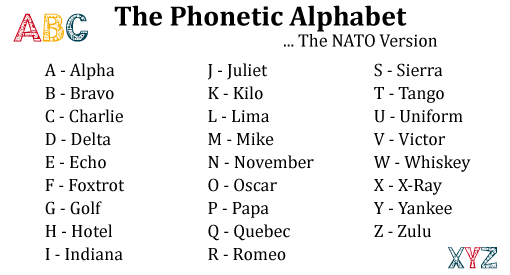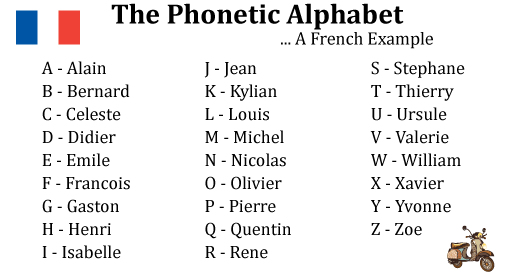Alpha, Bravo, Charlie, Delta, Echo, Foxtrot, Golf, Hotel, Indiana, Juliet, Kilo, Lima, Mike, November, Oscar, Papa, Quebec, Romeo, Sierra, Tango, Uniform, Victor, Whiskey, X-ray, Yankee, Zulu make up the 26 words of the NATO phonetic alphabet.
Here we explain what the phonetic alphabet is, how it helps customer service teams, and its role in CX.
What Is the Phonetic Alphabet?
The phonetic alphabet is a list of 26 words, each beginning with a different letter of the alphabet. When spoken out loud, each word represents the letter that it begins with.
Less commonly known as the “military alphabet” or the “spelling alphabet”, the phonetic alphabet is often used to clear up any misunderstanding over the pronunciation of letters.
This can be very helpful in day-to-day life, as I’m sure we’ve all mistaken an “M” for an “N” or a “B” for a “P”. But it can be even more beneficial in the contact centre environment.
What Is the NATO Phonetic Alphabet?
A for Alpha, B for Bravo, C for Charlie, D for Delta…
Here is the phonetic alphabet, as first introduced by NATO in 1955:

FREE Printable NATO Phonetic Alphabet
Do you want to download this to share with your team?
Get your free NATO phonetic alphabet in printable PDF format now:
If you want to find out more about the NATO phonetic alphabet, read our article: NATO Phonetic Alphabet – Free Download
It Is Different in the US and France!
While many English-speaking countries and other European countries use the NATO phonetic alphabet, many use different versions – with the US and France being notable exceptions.
In the US, it is common to use names and cities to identify the letter at the start of the word, while the police use a different phonetic alphabet than the military, which is just as common.
Below is the New York Police Dept. Phonetic Alphabet, which is sometimes used in US contact centres.

In certain other countries, including France, however, there is no “standard” phonetic alphabet. Instead, French contact centres often use names that are appropriate for their customer base.
For example, a French contact centre could use the following names as a phonetic alphabet when dealing with customers.

Creating a set of names like this can be a great alternative if you handle calls from international customers and where English is sometimes not best understood.
To find out more about the French alphabet, read our article: French Phonetic Alphabet – Free Download
When the Phonetic Alphabet Can Be Extremely Useful in the Contact Centre
Ever found yourself wondering what p is in the phonetic alphabet and substituting with a clumsy alternative of ‘pen’ or ‘park’ instead of professionally saying ‘papa’?
That’s why the phonetic alphabet is a great contact centre tool, as following the principle of checking information to make sure you get it right is a fundamental part of good customer service.
While some organizations may see the phonetic alphabet as being too formal a tool to coach advisors, there is no doubt that a tool designed to clarify communication can be beneficial.
In fact, here are three contact centre scenarios for when using the phonetic alphabet can prove itself to be very helpful.
- To record customer information – The phonetic alphabet can help you to spell difficult names and get email addresses and postcodes right, making it easier to clarify information with customers during phone calls.
- To share information with customers – When sharing web links or passing on any other information, it is good to use the phonetic alphabet to avoid any misunderstanding – particularly with vulnerable customers who may have hearing difficulties.
- To break down language/accent barriers – It is a good way to overcome any barriers when the customer’s English is a problem, ensuring accurate communication.
However, there are more benefits than just clearing up conversations, as we explore below…
The Hidden Benefits of Using the Phonetic Alphabet
When you, as an advisor, use the phonetic alphabet, it demonstrates that you pay attention to detail, want to get it right first time and conduct yourself in a professional manner.
Each of these attributes is desirable in an advisor, and if the customer perceives you as knowing your stuff, as suggested by a good knowledge of the phonetic alphabet, they are less likely to challenge your ideas and recommendations.
When this happens you improve both professionalism and contact centre efficiency simultaneously.
Also, you can improve efficiency through improving data accuracy, as you are much more likely to accurately record customer information by using the phonetic alphabet.
Why NOT Using the Phonetic Alphabet May Cost Your Business
While so far we’ve only talked about the benefits of using the phonetic alphabet, there are drawbacks to not using this coaching tool at all.
The obvious drawbacks are risking errors in communication and data recording. Remember, these errors have a cost, both in terms of losing customers and reputation.
Story Time Now!
In August, I had a car puncture on a motorway while crossing the Prince of Wales bridge. I pulled over and, as I had breakdown and accident cover, phoned my provider.
I told the advisor where I was using a code on a nearby driver location sign, such as are located every 500 metres along English/Welsh motorways.
The advisor told me that a recovery vehicle was on the way and it would be 45 minutes. After an hour and a half, I phoned back, only to realize that the advisor had taken down the code wrong – the recovery vehicle had gone to the wrong bridge.
Once the mistake had been rectified, I had to wait for a new driver. All in all, I was waiting on the side of a dangerous motorway for almost four hours, losing half a day’s pay.
Not only will I being reconsidering my breakdown cover provider, imagine the cost to that organization of that simple mistake in terms of staffing and petrol also.
So, while the phonetic alphabet may be considered overly formal for some organizations, consider the problems that you may face if you are not coaching this tool.
Training the Phonetic Alphabet
One barrier to using this coaching tool in the contact centre is that it is difficult to find an engaging way to coach advisors on the phonetic alphabet.
Fun training exercises that have become a key staple of every contact centre’s training plan, but that doesn’t mean that you can’t get creative!
For example, you can use training sessions to get advisors to spell their names using the phonetic alphabet or you can spell out instructions using the phonetic alphabet and ask advisors to “decode” them.
Also, we can ask advisors to spell out other things using the phonetic alphabet, such as where they live, where they last went on holiday and so on.
We can add these as quick little tests to our refresher training sessions or into fun quizzes, which we design to be fun and pacy to re-engage advisors.
Let Advisors Have Fun With It!
Engaging advisors with the phonetic alphabet is a tricky task, but there are no hard rules of sticking to the words used in NATO’s commonly used “edition”. In fact, our readers tell us it can be more fun to mix things up a little.
Charles Williams of Forum Events says: “I have had my agents learn it as part of their training. Although they usually stick to the “traditional” phonetic alphabet, the agents do sometimes substitute their own when necessary like A = apple. It does get quite creative!”
While this may take away from the professionalism of it all, particularly if you are part of a high-end brand, it can be a nice way for advisors to clarify things without knowing the phonetic alphabet off by heart.
However, Diane Banister of Intelligent Dialogue, does warn us: “I’ve heard “N” for knickers on my travels, which is wrong on so many levels!”
There are other ways to make the phonetic alphabet fun, though, potentially by asking advisors to add to illustrations of the 26 words across the contact centre walls.
This idea can be a nice hack for teaching advisors the phonetic alphabet, while it may also be good to make it available on advisor desktops, just in case the word for one letter slips their mind.
Or you could perhaps create a song that includes each word of the phonetic alphabet – that would no doubt lead to a memorable coaching session.v
If you are looking for real information on, or printable versions of, the phonetic alphabet – we’ve got you covered, just check out these next:
- UK Phonetic Alphabet – Free Download
- Spanish Phonetic Alphabet – Free Download
- Comedy Phonetic Alphabet – Free Download
- Australian Phonetic Alphabet – Free Download
Author: Charlie Mitchell
Reviewed by: Robyn Coppell
Published On: 25th Nov 2019 - Last modified: 12th Aug 2025
Read more about - Definitions, Call Handling, Charlie Mitchell, Customer Service, Forum Events, Free Downloads, Language, Phonetic Alphabet, Popular, Terminology, Training and Coaching





















